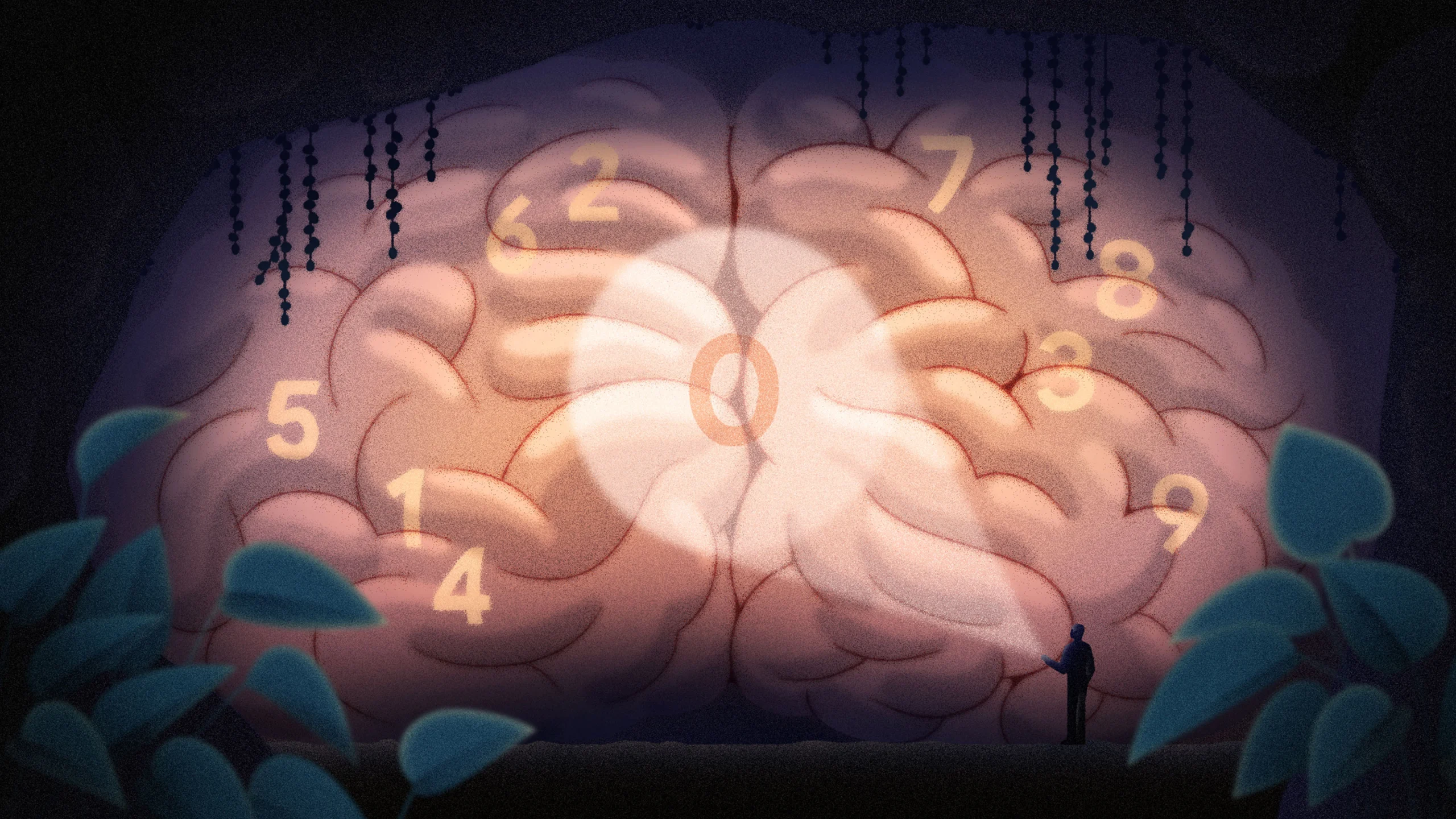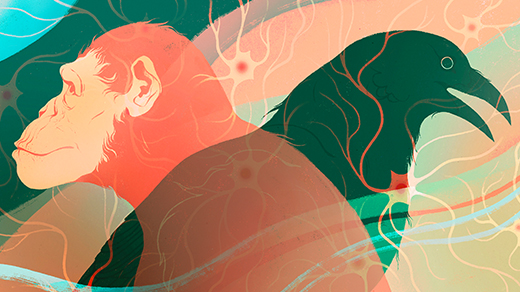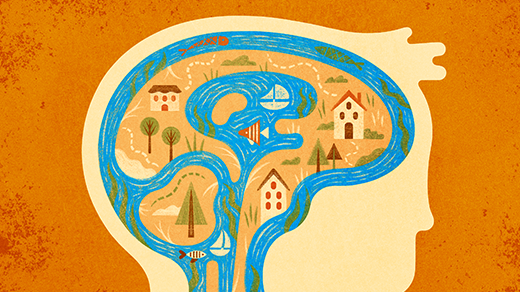How the Human Brain Contends With the Strangeness of Zero
Introduction
Around 2,500 years ago, Babylonian traders in Mesopotamia impressed two slanted wedges into clay tablets. The shapes represented a placeholder digit, squeezed between others, to distinguish numbers such as 50, 505 and 5,005. An elementary version of the concept of zero was born.
Hundreds of years later, in seventh-century India, zero took on a new identity. No longer a placeholder, the digit acquired a value and found its place on the number line, before 1. Its invention went on to spark historic advances in science and technology. From zero sprang the laws of the universe, number theory and modern mathematics.
“Zero is, by many mathematicians, definitely considered one of the greatest — or maybe the greatest — achievement of mankind,” said the neuroscientist Andreas Nieder, who studies animal and human intelligence at the University of Tübingen in Germany. “It took an eternity until mathematicians finally invented zero as a number.”
Perhaps that’s no surprise given that the concept can be difficult for the brain to grasp. It takes children longer to understand and use zero than other numbers, and it takes adults longer to read it than other small numbers. That’s because to understand zero, our mind must create something out of nothing. It must recognize absence as a mathematical object.
“It’s like an extra level of abstraction away from the world around you,” said Benjy Barnett, who is completing graduate work on consciousness at University College London. Nonzero numbers map onto countable objects in the environment: three chairs, each with four legs, at one table. With zero, he said, “we have to go one step further and say, ‘OK, there wasn’t anything there. Therefore, there must be zero of them.’”

Inside the Chaturbhuj Temple in India (left), a wall inscription features the oldest known instance of the digit zero, dated to 876 CE (right). It is part of the number 270.
From left: Creative Commons / ccarlstead
In recent years, research started to uncover how the human brain represents numbers, but no one examined how it handles zero. Now two independent studies, led by Nieder and Barnett, respectively, have shown that the brain codes for zero much as it does for other numbers, on a mental number line. But, one of the studies found, zero also holds a special status in the brain.
“The fact that [zero] represents nothing is a contradiction in itself,” said Carlo Semenza, a professor emeritus of neuroscience at the University of Padua in Italy who wasn’t involved in either study. “It looks like it is concrete because people put it on the number line — but then it doesn’t exist. … That is fascinating, absolutely fascinating.”
The new studies are the first to reveal what goes on in the brain when a person thinks about zero, and they bring up broader questions about how the mind handles absence — a pursuit that would have pleased Jean-Paul Sartre, the 20th-century existentialist who claimed that “nothingness carries being in its heart.”
Thinking About Nothing
The idea of zero, originally called sunya for “empty” in Sanskrit, first made its way out of India to the Arab world. Then, in the 13th century, a humble traveler by the name of Fibonacci picked up the idea in North Africa and brought it back to medieval Europe, along with the base-10 number system and Indo-Arabic numerals.
Mark Belan/Quanta Magazine
At first, zero caused confusion. “Its ability to represent ‘nothing’ and enable complex mathematical operations challenged deeply ingrained theological and philosophical ideas,” Nieder said. Particularly due to the influence of the church, philosophers and theologians associated “nothing” with chaos and disorder and were disinclined to accept it. Many even feared it, considering it “the devil’s number,” Barnett said.
But soon, merchants recognized that zero was valuable for business. By the 15th century, it had become widespread in commerce, finance and mathematics across Europe, but never shed its aura of mystery. “If you multiply a number by zero, it disappears. That was really hard to understand,” Semenza said. That feeling persists today: Although zero is now pervasive and seemingly simple, math students and mathematicians alike continue to wrestle with it.
Zero is the “eccentric uncle in the family of numbers,” Nieder said. To use zero in calculations, mathematicians had to establish all sorts of rules. You can’t divide any other number by zero, but you can divide zero by any other number. A nonzero number to the power of zero gives you one; zero to a power of a nonzero number gives you zero, but zero to a power of zero gives you a calculator error — and a headache.
Yet “the idea of zero, or something that plays the role of a zero, somehow appears all over math,” said Neil Barton, a philosopher of math at the National University of Singapore. Without it, modern mathematics wouldn’t exist — you wouldn’t be able to solve a function, do calculus or distinguish between 1 and 1 million.

The neuroscientist Andreas Nieder is fascinated by how animals and human brains handle the number zero, which he calls the “eccentric uncle” of numbers.
Courtesy of Andreas Nieder
However you look at it, zero is unique. For researchers interested in how the brain handles numbers, zero was “the most fascinating number of them all,” Nieder said. He suspected that if zero is special in history and math, then the brain must process it specially, too.
Nieder’s group has previously shown that some neurons in the brain have favorite numbers. Some favor 3 and will fire more rapidly when presented with three apples, for example, than they would with two or four — and much more than with five or seven. The more rapidly neurons fire, the more interested they are in a specific number. This is true not only in humans but also in other animals. While nonhuman animals don’t understand numbers when they’re represented as digits — an entirely human construct — they can estimate quantities, also known as numerosities. Researchers previously found that monkeys and crows have neurons that are specifically tuned to the numerosity zero.
But until very recently no one had ever probed for the neural basis of zero in humans.
“Just Another Number”
Barnett was interested in absence before he was interested in zero. The majority of consciousness and perception science over the last century has focused on what happens in the brain when we detect something in the environment. “But this ignores the whole other side of things,” he said, “which is that you can often have experiences of something not being there.” For example, if you go to grab your keys and they aren’t where you left them on the hallway table, you experience absence.
Previously, researchers assumed that absence was represented in the brain by neurons not firing. But recent studies have shown that the brain encodes absence with unique neural patterns. To push this work further, Barnett turned to zero, “a concept of absence that all of us are familiar with,” he said.

Benjy Barnett, a graduate student at University College London, is using zero to probe the broader phenomenon of how the brain handles absence.
Georgina Miller-Molloy
A few years ago, Barnett began his absence studies with the number zero. He recruited 24 participants to perform tasks related to zero as they sat in a magnetoencephalography scanner, which “looks like these old-school hairdresser” machines, he said. As neurons fire, they generate voltages, which in turn create a magnetic field that can be detected by the machine. By analyzing the magnetic fields, researchers can learn how populations of neurons respond when prompted to think about specific topics, such as zero.
Barnett and his adviser at University College London, Stephen Fleming, were looking for evidence of the numerical distance effect, a phenomenon that occurs when the brain processes nonzero numbers. Basically, the brain can more easily distinguish between two numbers if they are far apart on the number line than if they are close together. So it confuses 6 and 7 more often than 6 and 9. The researchers figured that if the brain processes zero similarly to other numbers, it should also show the numerical distance effect.
Indeed, in results published in Current Biology in August, Barnett and Fleming concluded that the brain treats zero, both as a digit and as a quantity, in much the same way that it treats the other numbers. “Zero is represented on this neural number line,” Barnett said.
Nieder, for his part, has been obsessed with zero and absence for the better part of a decade. In 2016, he proposed that the neurological mechanisms that encode absence may be shared with those that encode zero. He hypothesized that zero must have evolved from more fundamental representations of perceptual absence. First, the brain had to understand the absence of a stimulus, like a light being off; only then could it recognize “nothing” as a category akin to “something,” but representing everything that isn’t something. Finally, it had to turn “nothing” into a quantitative concept. By understanding how the brain encodes zero, he believed, we might be able to understand how the brain deals with absence.
Since 2015, Nieder has collaborated with Florian Mormann, the head of the cognitive and clinical neurophysiology group at the University of Bonn, who treats epilepsy patients. For their treatment, these patients have electrodes implanted in their brains, which Mormann can use to collect neuroscience research data with patient consent.
Mormann recorded brain activity from single neurons as the patients performed number-related tasks. In the analysis, he and Nieder first focused on nonzero numbers and found that the brain processes large numbers differently than smaller ones. Then they went back to their data to focus only on zero.
As they reported in Current Biology in September, Nieder and Mormann found the same thing Barnett had, that zero exhibited a numerical distance effect in the brain. That means that, to the brain, zero is just another number, Nieder said.
Or is it?
“When one looks closely,” he said, “zero is still an outlier among the other numbers.”
What Makes Zero Special
Nieder’s team found some differences between the way the brain represents zero and the way it handles other numbers. For one thing, more neurons had zero as their preferred number than any other small number. Because there are more neurons that code for zero, the brain can represent the empty set with more accuracy than it can represent other small quantities, they found.
“Zero is encoded together with other small numbers, but it is represented more distinctly compared to them,” Nieder said. “It is simply an eccentric outlier and represented as such in the brain.”
However, they didn’t find any difference in accuracy in the way the brain represented the digit version of zero — 0 — compared to the other digits. “All number symbols are abstractions, functioning as formal symbols within a symbolic system,” Nieder said. “As such, zero is treated like any other formal number.”

In the Bakhshali manuscript, an Indian mathematical text dated to the fourth century, a placeholder zero is represented as a dot.
The Bodleian Libraries, University of Oxford
Nieder’s findings are slightly different than Barnett’s. Barnett didn’t observe any distinctions, even slight ones, in the way zero was represented compared to other numbers.
What could explain the discrepancy? After being asked to look at each other’s papers, Barnett and Nieder agreed that their findings are complementary. Any differences, they said, most likely have to do with scale: Barnett’s study looked at large populations of neurons, while Nieder’s looked at single neurons.
Brian Butterworth, a cognitive neuroscientist at University College London, noted that the studies’ differences could instead be due to the studied brain area. Barnett’s group was able to examine the entire brain, including the parietal cortex, the region that’s considered the hub for processing numbers. However, Nieder and Mormann were limited by where patients’ electrodes were placed; they closely examined single neurons in the medial temporal lobe, which is known for processing memory. “It’s like looking for your lost keys under the lamppost,” Butterworth said. The pair might have accidentally surveyed “memories for zero,” he added, rather than the digit or idea itself. Nieder disagreed: That area of the brain, as well as many others, has also been found to be able to process numbers, he said.
Despite the differences, the results excited Semenza. He had previously hypothesized that zero would have a place on the mental number line and not be a distinct concept from other numbers. “I wish I would’ve done these experiments myself,” he said.
All the researchers agreed that these studies are only a start in uncovering how our brains process zero, and how to reconcile its different modes. Neither of the research groups, for example, looked at how the brain processes “zero” as a written word.
“How many different zero concepts are there, and how are we able to unify these ideas under one umbrella?” Barton said. “This is well understood mathematically, but I’d love to see more from the neurobiologists.”
While Nieder hopes to continue dabbling in the world of number neuroscience, Barnett has his sights set on the concept of absence. If he can find similarities in how the mind represents zero and absence, he said, then maybe Nieder’s theory is right — that zero might have evolved from a more fundamental ability to grasp the idea that “nothing” really is “something.”







